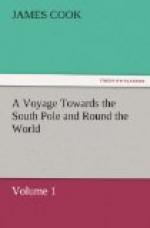As we had now got to the northward of Captain Carteret’s tracks, all hopes of discovering a continent vanished. Islands were all we were to expect to find, until we returned again to the south. I had now, that is on this and my former voyage, crossed this ocean in the latitude of 40 deg. and upwards, without meeting any thing that in the least induced me to think I should find what I was in search after. On the contrary, every thing conspired to make me believe there is no southern continent, between the meridian of America and New Zealand; at least, this passage did not produce any indubitable signs of any, as will appear by the following remarks. After leaving the coasts of New Zealand, we daily saw floating on the sea rock-weed, for the space of 18 deg. of longitude. In my passage to New Zealand in 1769, we also saw this weed, for the space of 12 or 14 deg. of longitude before we made the land. The weed is undoubtedly the produce of New Zealand; because the nearer the coast, the greater quantity you see. At the greatest distance from the coast, we saw it only in small pieces, generally more rotten, and covered with barnacles, an indubitable sign that it had been long at sea. Were it not for this, one might be led to conjecture that some other large land lay in the neighbourhood; for it cannot be a small extent of coast to produce such a quantity of weed, as to cover so large a space of sea. It hath been already mentioned, that we were no sooner clear of the straits, than we met with a large hollow swell from the S.E., which continued till we arrived in the longitude of 177 deg. W., and latitude 46 deg.. There we had large billows from the N. and N.E., for five days successively, and until we got 5 deg. of longitude more to the east, although the wind, great part of the time, blew from different directions. This was a strong indication that there was no land between us and my track to the west in 1769. After this, we had, as is usual in all great oceans, large billows from every direction in which the wind blew a fresh gale, but more especially from the S.W. These billows never ceased with the cause that first put them in motion; a sure indication that we were not near any large land, and that there is no continent to the south, unless in a very high latitude. But this was too important a point to be left to opinions and conjectures. Facts were to determine it, and these could only be obtained by visiting the southern parts; which was to be the work of the ensuing summer, agreeable to the plan I had laid down. As the winds continued to blow from the N.W. and W., we had no other choice but to stand to the north, inclining more or less every day to the east. In the latitude of 21 deg. we saw flying-fish, gannets, and egg-birds. On the sixth, I hoisted a boat out, and sent for Captain Furneaux to dinner, from whom I learnt that his people were much better, the flux having left them, and the scurvy was at a stand. Some cyder which he happened




